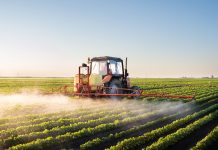Curtis R Youngs, Professor & M.E. Ensminger Endowed Chair of International Animal Agriculture, continues the discussion of the challenges of global food security
Societies are faced with unprecedented global food security challenges due to a myriad of factors such as rampant global inflation (9.2% in March 2022)(1), climate change that is adversely impacting agricultural productivity(2), and disruptions in the food supply chain caused by the Russian invasion of Ukraine.
Between 720 and 811 million people faced hunger during the year 2020(3), and an estimated 47 million additional people will face acute hunger in the 81 countries where the World Food Programme (WFP) operates – due solely to the Russian invasion of Ukraine(4). When one considers citizens in countries where WFP does not operate, persons facing hunger could easily surpass 900 million (approximately one in every nine people globally).
Global food security programs and human consumption
A variety of different organisations, foundations, and governmental agencies have developed programs to address the massive societal problem of hunger. Those food security programs were designed to increase awareness of the problem, develop strategies to combat the issue, and implement specific action steps to reduce the number of people affected by hunger and malnutrition. Food insecurity knows no geographical boundaries. For example, 10.5% of all households (116.7 million people) in the United States were food insecure in 2020(5) – and this global food security crisis is only growing.
Although it is commonly believed that there is a sufficient quantity of food being produced at present to feed every man, woman and child on the planet, the figures on hunger tell a different story. Why does this apparent discrepancy between common belief and reality exist? Perhaps the reason lies in the massive volume of “wasted food”.
Globally, one-third of food produced for human consumption is wasted (1.3 billion tons per year valued at $U.S. 1 trillion), and, if totally prevented, it would be enough food to feed two billion people(6). Herein lies the connection between the belief that enough food exists to feed the world’s population and the reality of hunger. If wasted food were a country, it would be the third-largest producer of carbon dioxide (a potent greenhouse gas that causes climate change) in the world – behind the U.S. and China(6).
Reducing wasted food
“Wasted food” is a term that the United States Environmental Protection Agency (EPA) has adopted in their systematic approach to developing a sustainable food management program. Their program seeks to reduce wasted food (and its associated impacts) over an entire life cycle – starting from the use of natural resources and continuing through manufacturing/processing, sales/ distribution, consumption (at home and in restaurants), and disposal(7).
The EPA definition of wasted food is “food that was not used for its intended purpose”, and the term “food waste” purposefully is avoided to encourage people to think more broadly about this problem. In 2015, EPA and the United States Depart- ment of Agriculture (USDA) joined forces with the goal of reducing wasted food in the U.S. by 50% before the year 2030. Most estimates indicate food wastage in the US at between 30 and 40% of the food supply.
Wasted food is generated through food loss from the agricultural sector (e.g., unharvested crops; loss of crops during harvest, transport, and storage; livestock death loss) and the consumer sector (e.g., unsold food from retail stores, food spoilage at home, uneaten meal portions). The U.S. EPA developed a “food recovery hierarchy” to identify actions that individuals and organisations can take to reduce wasted foods(8).

What is the food recovery hierarchy?
This inverse hierarchy (i.e., upside down triangle) has six categories. The five action categories are: 1) source reduction (reduce the volume of unused food generated), 2) feed hungry people (donate unneeded food to food banks and shelters), 3) feed animals (divert food scraps to animal feed), 4) industrial uses (generation of fuels and energy), and 5) composting (creating a nutrient-rich soil amendment). The sixth and final part of the hierarchy is landfill/incineration (which should be considered a last resort). In 2020, methane emissions from landfills accounted for 15% of total US methane emissions(9). The United Nations Environment Programme (UNEP) estimated that 8- 10% of all global greenhouse gas emissions are associated with food that is not consumed(10).
The UNEP Food Waste Index Report 202110 is heralded as the most comprehensive data collection, analysis, and modelling of food waste to date. (In this report, food waste was defined as “food and the associated inedible parts removed from the human food supply chain in the retail, food service, and household sectors”).
It also provides methodologies for countries to measure wasted food at the household, food service and retail levels and to track progress toward meeting sustainable development goal (SDG) target 12.3 (by 2030, to halve per capita global food waste at the retail and consumer levels and reduce food losses along production and supply chains, including post-harvest losses). This report revealed that the global average for wasted food is a whopping 74 kg per capita and was remarkably similar for lower-middle income countries and high-income countries. Food waste was generated 61% at the household level, 26% at the food service level, and 13% at the retail level.
So, what action steps can be taken immediately by citizens to reduce the problem of wasted food at the household, food service, and consumer levels?
Action steps to reduce wasted food include:
1. Pick one week to keep track of all food purchased and all food consumed. Attempt to quantify the amount of wasted food (either by weight or volume), the proportion of food wasted, and the associated cost of that wasted food. Set a goal for future weeks to reduce food waste.
2. Don’t go grocery shopping while hungry to reduce the likelihood of overbuying – particularly for perishable items such as fruits, vegetables, meat, milk, and eggs.
3. Educate yourself regarding the dates on food packaging (i.e., “use by” or “best buy”) and buy foods with a close “expiration date” if they can be consumed safely.
4. Consider working to pass laws that reduce legal liability for retailers and restaurants that donate food.
5. At restaurants, order smaller portion sizes (i.e., clean your plate) and/or take home any food you don’t consume for later consumption (using your own recyclable food container, if permitted by local law).
If everyone takes some small steps to reduce food waste, the collective benefits will undoubtedly help feed the world.
References
1. International Labour Organization, https://ilostat.ilo.org/inflation-more-than-doubled-between-march-2021-and-march-2022/ Inflation more than doubled between March 2021 and March 2022.
2. UNCCD (United Nations Convention to Combat Desertification). 2022. Drought in Numbers 2022: Restoration for Readiness and Resilience, https://www.unccd.int/resources/publications/drought-numbers
3. FAO (Food and Agriculture Organization of the United Nations). 2021. State of Food Security and Nutrition in the World 2021, https://www.fao.org/publications/sofi/2021/en/
4. WFP (World Food Programme). 2022. Projected increase in acute food insecurity due to the war in Ukraine. https://docs.wfp.org/api/documents/WFP-0000138289/ download/?_ga=2.7550202.939190995.1653923785-969885970.1653923785
5. USDA ERS (United States Department of Agriculture Economic Research Service). 2021. Household Food Insecurity in the United States in 2020. https://www.ers.usda.gov/webdocs/publications/102076/err-298.pdf?v=7092
6. WFP (World Food Programme). 2020. 5 facts about food waste and hunger. https://www.wfp.org/stories/5-facts-about-food-waste-and-hunger
7. EPA (United States Environmental Protection Agency). 2022. Sustainable management of food basics. https://www.epa.gov/sustainable-management-food/sustainable-management-food-basics
8. EPA (United States Environmental Protection Agency). 2022. Food recovery hierarchy. https://www.epa.gov/sustainable-management-food/food-recovery-hierarchy
9. EPA (United States Environmental Protection Agency). 2022. Basic Information about Landfill Gas. https://www.epa.gov/lmop/basic-information-about-landfill-gas
10. UNEP (United Nations Environment Programme). 2021. UNEP Food Waste Index Report 2021. https://www.unep.org/resources/report/UNEP-food-waste-index-report-2021
Please note: This is a commercial profile
© 2019. This work is licensed under CC-BY-NC-ND.
Contributor Details
Editor's Recommended Articles
-
Must Read >> Human & animal health, food security & biosecurity
-
Must Read >> Global food security analysis – part 1















